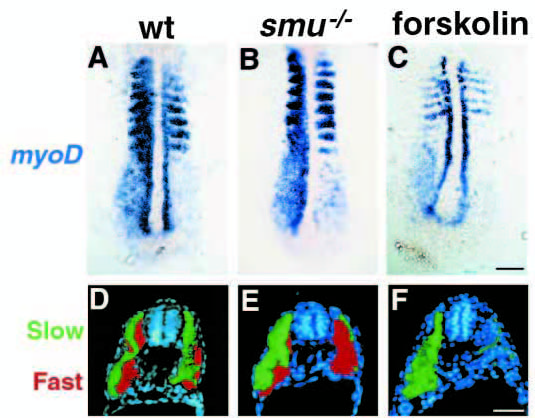Fig. 6 dnPKA overexpression in smu-/- and forskolin-treated embryos rescues slow muscle development. dnPKA mRNA was injected into forskolin-treated embryos and embryos derived from a cross of two animals heterozygous for smu mutations. (A-C) Dorsal view of embryos fixed at 12h and labeled by in situ hybridization for myoD. (A) In the majority of embryos (187/194), myoD expression is expanded into the segmental plate as a result of dnPKA overexpression. (B) In some of these embryos, myoD labeling on one side of the embryo shows the same pattern as injected wild-type embryos, whereas the labeling on the other side resembles uninjected smu mutant embryos. We interpret these as mutant embryos in which the dnPKA mRNA was effective only on one side of the embryo. (C) Forskolin-treated embryos also respond to dnPKA mRNA. (D-F) dnPKA mRNA injected embryos fixed at 30h and labeled for S58 (green) and zm4 (red). (D) In wild-type embryos most of the zm4-labeled fast muscle (red) is replaced by S58-labeled slow muscle (green), compare to Fig. 2J (see also Du et al., 1997). (E) Slow muscle is on occasion rescued by dnPKA overexpression only on one side (compare to Fig. 2K); we interpret these as smu-/- embryos. (F) dnPKA overexpression rescues forskolin-treated embryos; compare to Fig. 2L. See also Fig. 4. Bars, 100 μm (A-C); 50 μm (D-F).
Image
Figure Caption
Acknowledgments
This image is the copyrighted work of the attributed author or publisher, and
ZFIN has permission only to display this image to its users.
Additional permissions should be obtained from the applicable author or publisher of the image.
Full text @ Development

